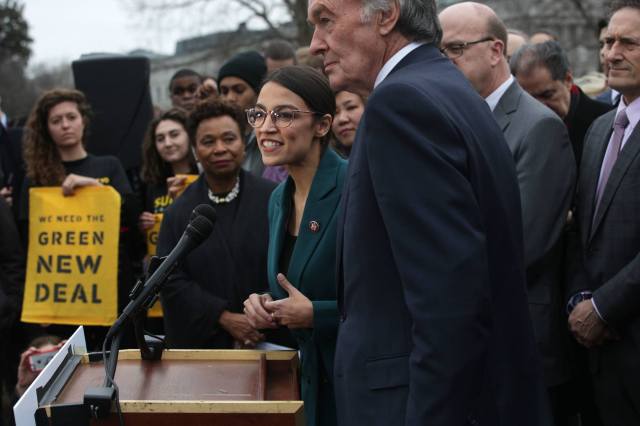Credit: Alex Wong/Getty Images

Spearheaded by Alexandria Ocasio-Cortez, the Green New Deal is a plan to fully decarbonise the US economy by means of a “10-year national mobilization”. There’s a whole lot of other stuff in there too – massive commitments to healthcare, housing, employment and other social goals – but let’s focus on the green bit, since it’s more than enough to be getting on with.
Given the ten-year time frame, it’s absurdly and obviously over-ambitious. Or is that just conventional wisdom speaking? Looking back, there’s a continuous record of official forecasters underestimating the progress that can be made on green technologies like wind and solar power.
There’s also a history of political resistance to any shift from fossil fuels – on the supposition that the alternative technologies aren’t ready yet. That’s a spurious argument, because new technology tends to get better and cheaper in the process of deploying it. As with so much in life, learning comes through doing. The fact that we’ve seen such dramatic cost improvements across a number of fronts – from offshore wind to LED lighting – shows that governments were right to kickstart markets through subsidies and other interventions.
Nevertheless, compared to what’s been achieved so far, the GND represents a whole new level of difficulty, requiring a much faster rate of progress across a much wider spectrum of technologies.
But for the sake of argument, let’s assume that the GND makes all the breakthroughs it requires as it goes along. With the right technology in hand, how much would it cost?
To get an idea, let’s turn to Michael Liebreich of BloombergNEF, who knows a thing or two about infrastructure investments that actually happen.
Totting up the decarbonisation aspects of the GND, Liebreich tentatively arrives at an annual capital investment figure of “$980 billion per year”:
“This is, of course, very much a back-of-envelope figure, as the text is heroically (and presumably deliberately) vague, but it confirms that the hard capital spending part of the GND would indeed be somewhere around the trillion-dollar per year mark.”
Is this remotely feasible? Liebreich deliberately leaves aside the question of how the US government might raise such a sum, or how it might pay it back. Instead, he asks a couple of really basic, but all important, questions.
Firstly, is there enough wealth lying around from which the capital required for the GND could, in principle, be raised? The answer to that one is yes:
“According to the Federal Reserve, the net wealth of U.S. households reached $109 trillion at the end of 2018, up from $60 trillion at the end of 2009. Even assuming that all of the GND capital spend is financed domestically, diverting $10 trillion over ten years into the GND’s clean energy, infrastructure and transport plans would absorb less than 10% of the nation’s savings.”
The second question is that, assuming it were raised, could the GND capital be spent? After all, the productive capacity of an economy, while not absolutely fixed, is finite – you cannot pay for more work to be done than there are workers and machines to do it. Furthermore, the rate at which capacity can be expanded is also limited:
“According to the Congressional Budget Office, at the end of 2018 U.S. economic output was 0.5% above its long-run potential. The U.S. has only ever run over 2% above its long-run economic potential for short periods, always followed by inflation, recession, or both.”
Liebreich calculates that “$1 trillion of GND spending would represent 4.9% of [US] economic activity” – thus, mathematically, the GND would require a diversion of economic activity on a “fairly grand scale”. Presumably, the units of measurement here would be hundreds of billions of dollars and millions of workers.
It is therefore entirely apt to describe the GND as a “national mobilisation”: it resembles a war effort.
Nevertheless, the American public appear to be up for it – and not just the youthful urbanites who vote for AOC and other radical Democrats:
“In one poll at the end of 2018, the Yale Program on Climate Change Communication and George Mason University found 81% of registered voters, including 64% of registered Republicans, supported shifting the U.S. to 100% renewable energy within 10 years.”
A cynic would say that those polled are simply expressing a view on an ideal world and that, unlike Michael Liebreich, they haven’t sat down and worked out the practicalities of making the dream come true.
But maybe the public are being more realistic than they’re given credit for. They can see for themselves how America’s trillions have been spent over the last twenty years – whether that’s on disastrous foreign wars, inflating the housing market, bailing-out the banks, pumping enormous sums into the world’s most expensive healthcare system, paying the price of unresolved social pathologies, supplying corporate welfare to the wealthiest corporations on the planet, and providing tax relief to billionaires. They look at all that, and so much more, and wonder if the money couldn’t be put to better use.
Far from perceiving the GND as a “socialist land grab”, to ordinary Americans it looks like an opportunity to take back control.
But that leaves one teeny-tiny little problem. Who exactly would the GND put in control? Who would be directing the flow of such vast sums of wealth on so accelerated a schedule? Who would have to work out the details of how to raise the capital and recoup the investment?
Would it be much the same ruling establishment that presided over the profligacy, waste and disaster of the last twenty years?
Or can we expect the likes of AOC and Bernie Sanders to make all the difference?










Join the discussion
Join like minded readers that support our journalism by becoming a paid subscriber
To join the discussion in the comments, become a paid subscriber.
Join like minded readers that support our journalism, read unlimited articles and enjoy other subscriber-only benefits.
Subscribe